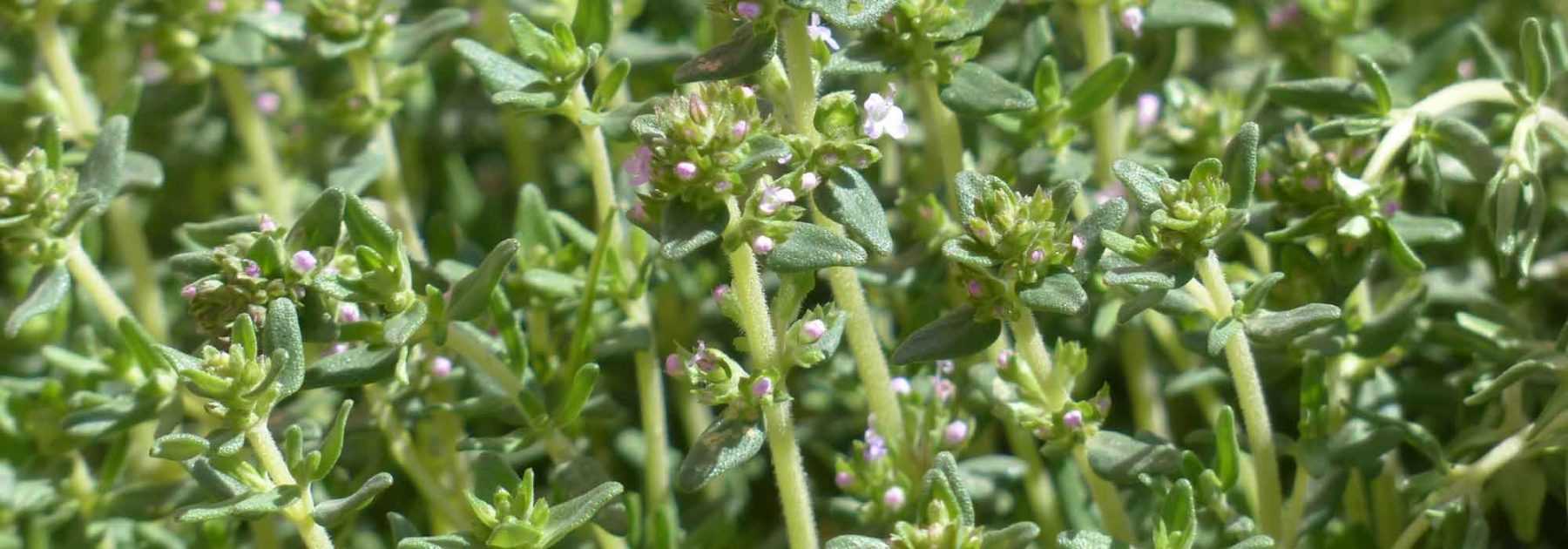
Thyme: Growing, Planting, Pruning
Contents
Thyme in a few words
- Thyme is a perennial, aromatic plant used both as a herb and for medicinal purposes.
- It can be grown in the garden but also thrives in pots on terraces or balconies.
- Thyme is an easy-to-grow plant that loves heat, sunshine and well-drained soil.
- Maintenance mainly involves an annual pruning.
- It’s essential in cooking, used either on its own or in bouquet garni to flavour numerous dishes.
Our expert's word
Thyme is an essential perennial aromatic, culinary and medicinal herb for any garden. Its highly fragrant leaves are used in cooking, either alone or in bouquet garni to flavour dishes, as well as for making herbal teas with various health benefits.
In gardens, you’ll most commonly find common thyme (Thymus vulgaris), prized for its flavour, ease of cultivation and good hardiness, as well as wild thyme, used as a fragrant ground cover. Lemon thyme (Thymus x citriodorus), increasingly popular, is grown and appreciated for its freshness. Other, less common varieties are still waiting to be discovered, such as Orange thyme with its citrus notes or Corsican thyme which evokes cumin!
Easy to grow in the ground, in pots or planters, on a windowsill or terrace, it particularly thrives in sunny, hot and even dry conditions which enhance its fragrance. It can be propagated by seed, division or cuttings and can be harvested year-round thanks to its evergreen grey-green foliage.
Don’t hesitate to plant it along vegetable garden borders, under fruit trees – ensuring it gets plenty of sun – or in an herb bed. Its powerful scent will deter certain aphids and molluscs, while attracting a myriad of pollinating insects when in flower. In the garden, feel free to mix things up by planting thyme among your perennial beds or in rockeries, where it will blend in beautifully. Moreover, the sometimes potent fragrances of aromatic plants often have the ability to repel insects that might attack more sensitive plants like certain roses.
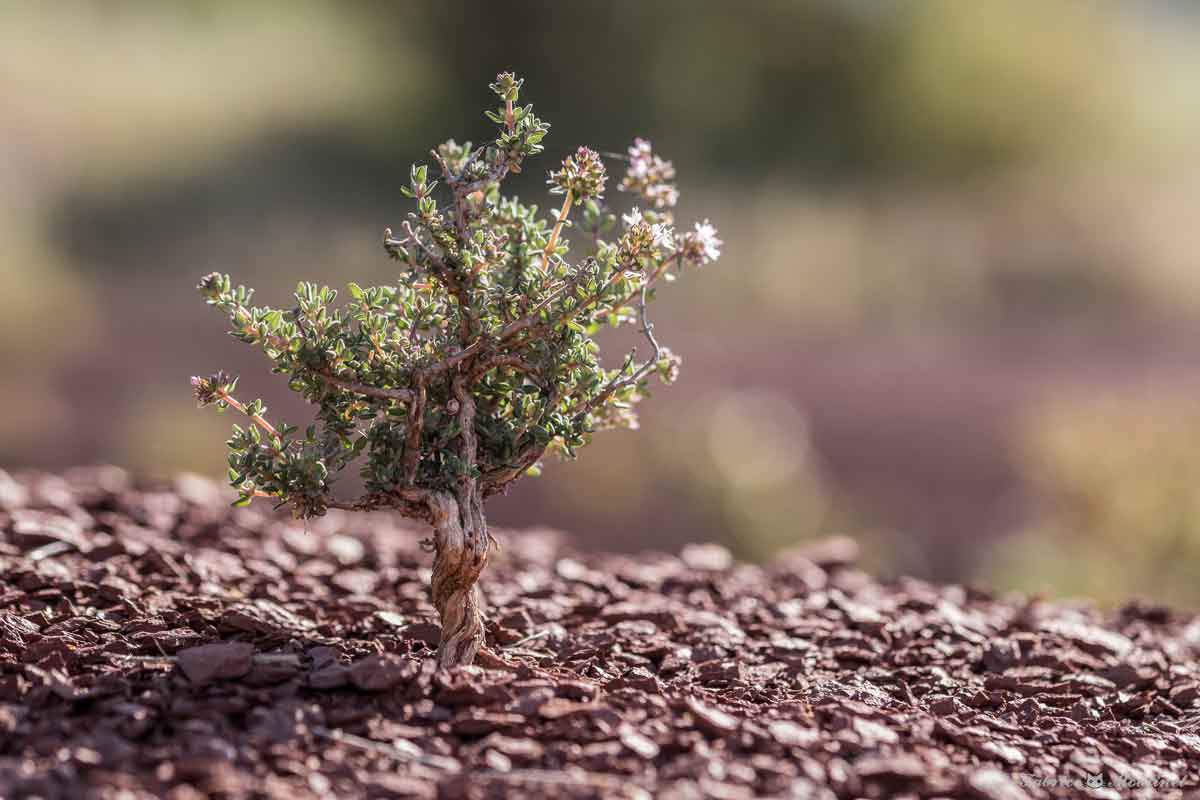
In its natural habitat, thyme doesn’t form such generous clumps as it does in gardens…
Description, origin and botany
Botanical data
- Latin name Thymus spp.
- Family Lamiacées
- Common name Thym
- Flowering Vivace
- Height 3 ans - Germination
- Exposure Soleil
- Soil type Sec, bien drainé, léger
- Hardiness -12°C à -15°C
Thyme is a plant native to Western and Southern Europe, particularly abundant in the Mediterranean basin as well as in East Asia and Japan. It is an extremely hardy plant that thrives in challenging conditions. In garrigue scrubland, it grows in full sun on rocky, dry and poor soils. The praecox species, better adapted to cold climates, grows wild in Iceland, Ireland, Scotland, southern parts of the UK and at high altitudes in the Alps. Today, the Thymus genus includes over 300 species and varieties.
The genus name Thymus derives from the Greek Thumon, meaning fragrance, referring to the scent emitted by this highly aromatic plant. Its common name, Thyme, stems from the Greek word. In southern France, it is also known as barigoule or farigoule. Wild thyme refers to another thyme species (Thymus serpyllum), characterised by its creeping habit, forming highly fragrant, lawn-like mats.
Common Thyme (Thymus vulgaris) is a perennial subshrub belonging to the Lamiaceae family. Small in stature, it grows 20 to 40 cm tall and forms clumps composed of numerous small, branched stems – herbaceous in the first year, becoming woody and gnarled in subsequent years. These bear small evergreen leaves, grey-green to silvery-green in colour, which release a strong fragrance when crushed.
Flowering begins as early as March in its natural habitat – the garrigue – and later in gardens (late spring to early summer). The flowers appear at the tips of stems, in the leaf axils, forming cyme inflorescences of tiny half-centimetre-long blooms, ranging from white to pink-mauve. These develop into minuscule brown seeds that retain their germination capacity for up to three years. They often self-seed spontaneously in vegetable gardens.
With good hardiness, thyme can withstand temperatures as low as -15°C, provided the soil is well-drained. This resilience diminishes in heavy, waterlogged soils!
Thyme flowers are particularly nectar-rich, attracting numerous pollinating insects. Beekeepers harvest a strongly flavoured thyme honey. You might even spot the endangered blue butterfly species that depends on thyme – it lays its eggs on thyme flower buds. This is the Large Blue butterfly (Phengaris arion)!
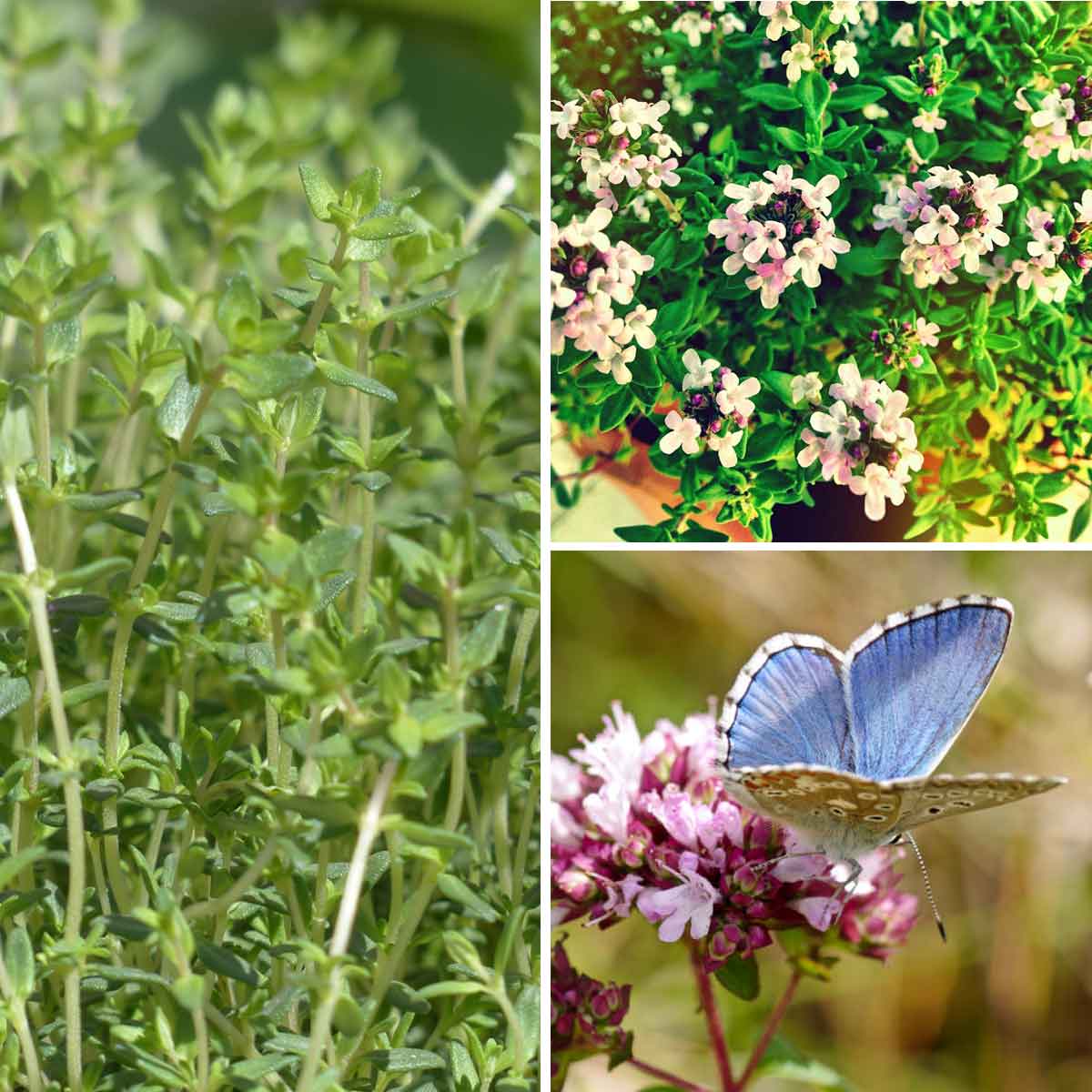
Herbaceous stems of common thyme – Thyme in bloom – The Large Blue butterfly
Read also
Basil: Sowing, Planting, GrowingSpecies and varieties of thyme
Among the many species and varieties of thyme, discover below a selection of the best varieties. They stand out for their growth habit, fragrance, flavour, hardiness and many other characteristics.
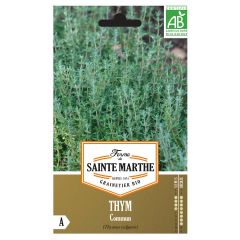
Thymus vulgaris Organic - Ferme de Sainte Marthe seeds
- Height at maturity 25 cm
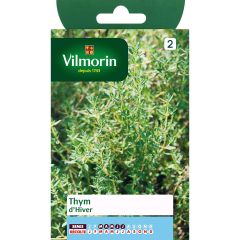
Thymus vulgaris Winter Thyme - Vilmorin seeds
- Height at maturity 30 cm
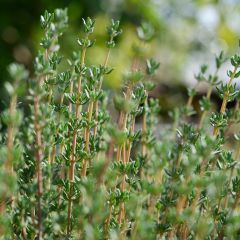
Thymus vulgaris Provence
- Flowering time July to September
- Height at maturity 25 cm
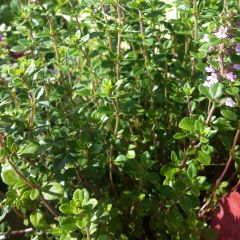
Thymus citriodorus - Lemon Thyme Organic
- Flowering time July to September
- Height at maturity 25 cm
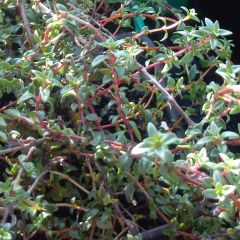
Corsican Thyme - Thymus herba-barona
- Flowering time July to September
- Height at maturity 15 cm

Thymus vulgaris Fragrantissimus - Orange Thyme in plants
- Flowering time July to September
- Height at maturity 25 cm

Thymus serpyllum - Ferme de Sainte Marthe seeds
- Flowering time July to October
- Height at maturity 15 cm
Discover other Thyme seeds
View all →Available in 1 sizes
Available in 1 sizes
Available in 2 sizes
Available in 1 sizes
Available in 1 sizes
Available in 1 sizes
Sowing thyme
Sowing thyme is a delicate process as the seeds are very small. To ensure success, it’s preferable to sow in pots or seed trays rather than directly in the ground. Sowing can be done in April or May. Note also that sowing thyme requires patience: the first harvest will only begin in the second year.
Sowing in pots or seed trays
To sow thyme seeds:
- Fill pots with special seed compost.
- Sow the seeds in clusters, with 4 to 5 seeds per cluster.
- Cover with a layer of compost equal to the thickness of the seeds – meaning very lightly for thyme!
- Water gently using a spray bottle and keep the surface moist until germination.
- To encourage germination, cover the pots with a pane of glass or a plastic bag, but remember to ventilate during the day once the seedlings appear.
- In autumn or the following spring, depending on the plants’ growth, transplant your thyme seedlings into the ground. Allow 30 cm in all directions between plants.
Read also
Parsley: Sowing, Planting, GrowingPlanting thyme, in the garden or in pots
Thyme thrives in light, even stony, well-drained soils. If your soil is rather damp and clayey, we recommend growing it in a pot where it will do very well. Planting takes place in spring (April-May) or autumn (September – October).
Planting in the ground
Choose a very sunny spot, planting is done in loosened and weeded soil. Space plants 30 cm apart in all directions.
To plant thyme in the garden:
- Dig a hole the size of the plant, enrich very lightly with mature compost (thyme thrives even in poor soil).
- Place one plant per planting hole.
- Cover with soil and gently firm down.
- Water for the first time. Rainwater warmed by the sun is always preferable.
To prevent the appearance of “weeds”, you can mulch around the base of your thyme. But remember its Mediterranean origins and opt for a mineral-based mulch instead.
Planting in pots
To plant thyme in pots or containers:
- Place a layer of gravel or clay pebbles at the bottom of the container to aid drainage.
- Fill with an equal mix of potting compost and garden soil, or pure potting compost… if you don’t have a garden!
- Position the root ball, cover with the soil/compost mix and firm down well.
- Water lightly.
- Place your pot in full sun.
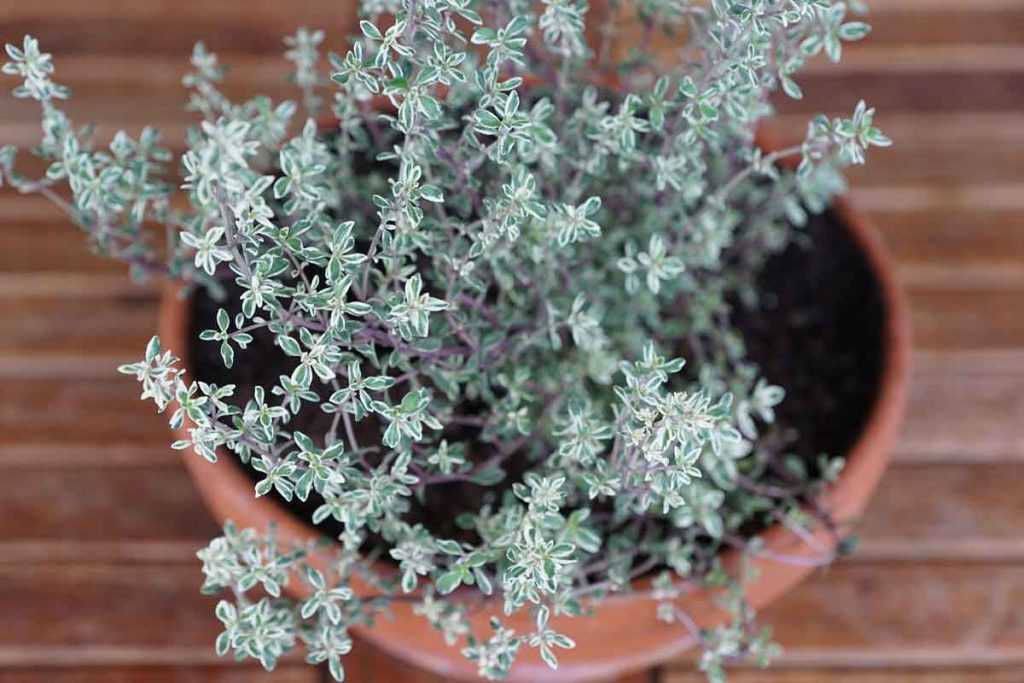
Thyme grows very well in pots
Discover our advice sheet for successfully growing thyme in pots.
Pruning thyme and watering
Thyme is a herb that requires very minimal maintenance, consisting mainly of pruning and watering only in cases of severe and prolonged drought.
Pruning thyme
Thyme naturally tends to spread open, revealing a bare centre, which isn’t always aesthetically pleasing, especially when grown in pots. An annual pruning in spring helps maintain a nice, compact and rounded shape. To do this, remove overly outward-growing branches and cut back last year’s growth. Use shears to trim half of the shoot (the herbaceous part) to encourage dense regrowth.
→ Learn more in our tutorial: Pruning thyme.
Watering thyme
Water very sparingly (if at all), mainly in summer, as thyme dislikes excess moisture. For pot-grown thyme, water regularly but avoid letting water stagnate in the saucer.
Harvesting and Storage
Thyme can be harvested all year round as its leaves are evergreen. It’s best picked in the morning. Thyme is more fragrant and richer in active compounds at the start of flowering. When pruning to maintain its lovely compact shape, take the opportunity to stock up for the winter months! Ideally for the plant’s health, harvest two-thirds of the herbaceous growth to encourage regrowth.
Thyme is traditionally preserved by drying. After washing and drying the stems, hang the bunches upside down in a dry, airy and dark place. Once dried, store the thyme away from light. This is a simple and quick process, though you may prefer freezing as a more convenient alternative to drying.
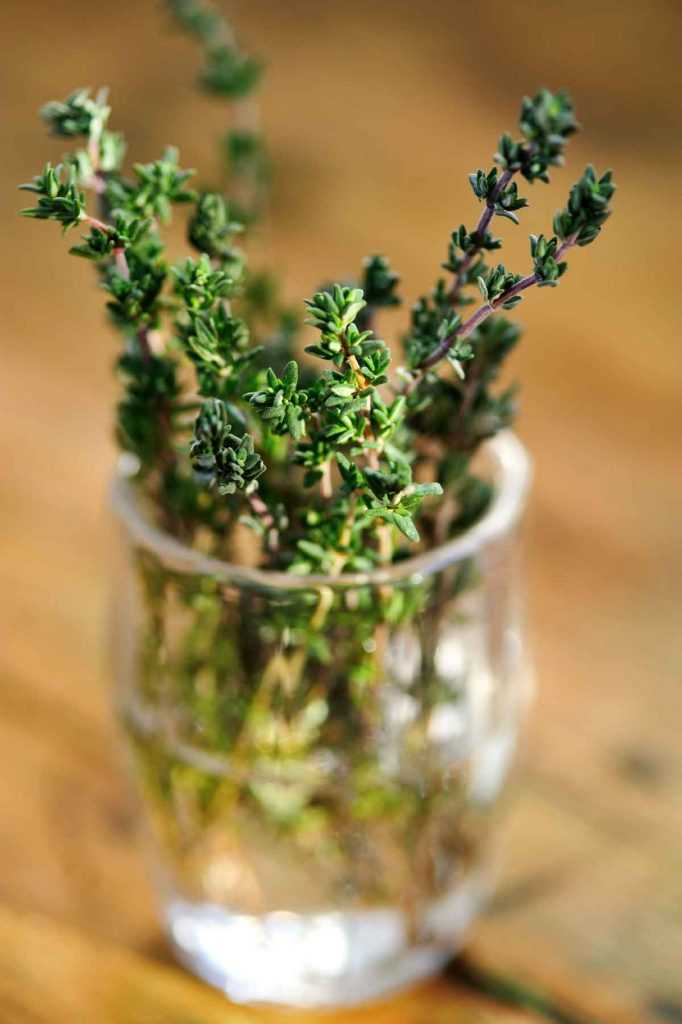
Discover our tutorial: How to Dry Thyme?
Uses and Benefits
The thyme leaves, with their garrigue fragrance, are highly prized in cooking. Used alone or in a bouquet garni, combined with bay leaves, parsley, and rosemary, they flavour stews, sauces, marinades, and court-bouillons. The thyme flowers, less common in cooking, add originality and taste to your dishes! They are best used fresh, right after harvesting, for example to enhance sauces, season and garnish a dish, or to give a real boost to your desserts and pastries, such as in a lemon and thyme flower cake.
The properties of thyme are remarkable for relieving various ailments and for stimulating and strengthening the immune system. It is an excellent antiseptic for the respiratory tract. It is most commonly used as an infusion of leaves (herbaceous stems), but also in the form of essential oils. The latter, depending on their main constituents (their chemotypes), can sometimes be very potent and are reserved for adults—always seek advice from your pharmacist before using them.
Read our advice in How to Naturally Treat a Cold with Thyme?
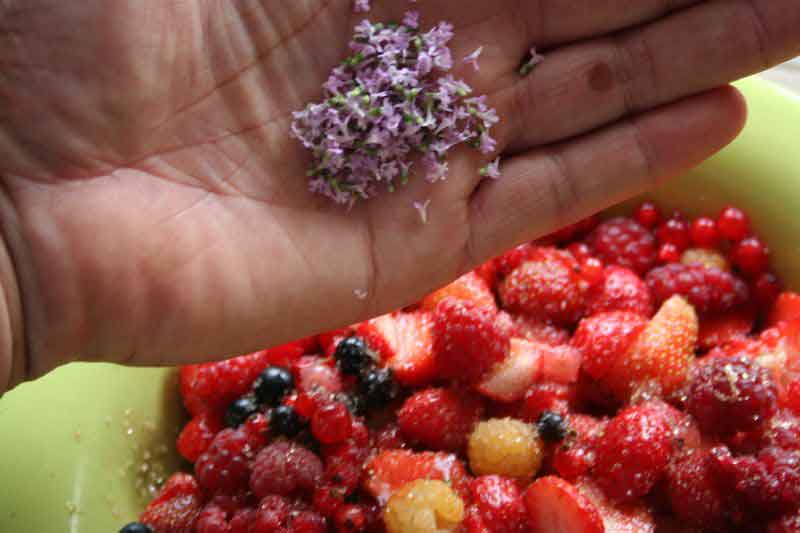
Propagating Thyme
Thyme can be propagated by dividing clumps or through cuttings, at any time of year. This operation is recommended after a few years, particularly in cold and damp climates, to renew the plants.
Dividing clumps
Dividing clumps is the easiest and most effective method for propagating thyme. To divide your thyme plants:
- Lift the clumps.
- Divide into several sections using secateurs. Ensure each section has roots.
- Replant the sections in pots or directly in the ground, covering the crown with soil.
- Water to encourage the plants to establish.
Taking cuttings
Cuttings are less reliable than dividing clumps but are still possible. To take thyme cuttings:
- Take 20cm-long stems.
- Bury two-thirds of the stem in soil and firm down.
- Water regularly for 2 months to encourage rooting.
- Plant out the following spring, in April-May once all risk of frost has passed.
→ Learn more with our tutorial: How to propagate thyme?
Self-seeding
To propagate thyme, you can also rely on self-seeding! After flowering, thyme will set seed each year. It’s common for some of these seeds to germinate and produce new plants near the parent plant. Keep an eye out during weeding—thyme seedlings are quite discreet! Once spotted, simply transplant them to the desired location or let them fill your herb patch.
Did you know?
Thyme has been known since antiquity, particularly celebrated by the Greeks who burned it in their temples. In Greek mythology, the most beautiful woman in the world and Queen of Sparta, Helen (daughter of Zeus and Leda), was charmed by Paris, a Trojan prince, who convinced her to accompany him to Troy. Menelaus, Helen’s husband, furious, triggered the Trojan War to reclaim her. Legend has it that thyme was born from Helen’s tears.
Useful resources
- Discover our wide range of thyme: many varieties are available as seeds or plants.
- Also explore creeping thyme as a lawn alternative
- Read our advice sheet: How to choose thyme?
- Discover 8 aromatic plants for Mediterranean cuisine
- How to treat a sore throat with thyme?
Frequently asked questions
-
How to preserve fresh thyme?
Fresh thyme, harvested in early summer, is rich in flavour and active compounds, making it the perfect time to stock up.
Fresh thyme keeps well when frozen. A very handy technique is to freeze it in ice cube form. The thyme is chopped and placed in ice cube trays filled with water. You can then simply use the desired number of thyme-infused ice cubes in your dishes.
-
Are thyme flowers edible?
Thyme flowers are entirely edible. Left on the stems (with the leaves), they will flavour various dishes and desserts. They can also be separated from the stem to garnish dishes or add an extra touch to desserts.
-
Why is my thyme drying out and dying?
Thyme decline can be due to various causes:
- Excess water in the garden or in pots is a possible cause of thyme decline. Soil that is too heavy (too clayey) and waterlogged from autumn to early spring will not suit thyme. - While thyme dislikes excess water, lack of water is equally harmful. In the garrigue, in poor, dry soil, thyme will develop according to its environment, meaning the stems won't necessarily be very vigorous. In a vegetable garden or pot, the soil is much richer, and thyme develops its herbaceous parts vigorously. These plants need more water to meet their higher water requirements. They are less resistant to water shortage than in their natural habitat.
- Subscribe!
- Contents


































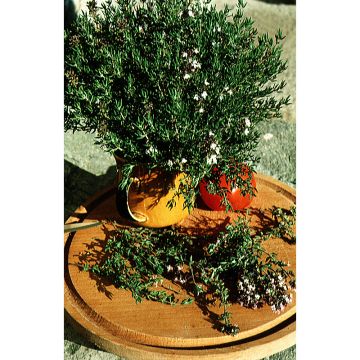
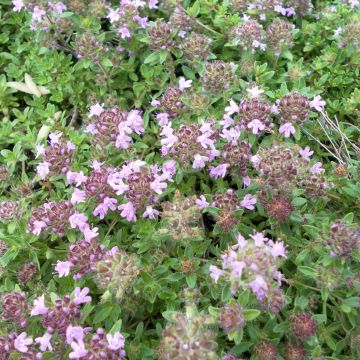
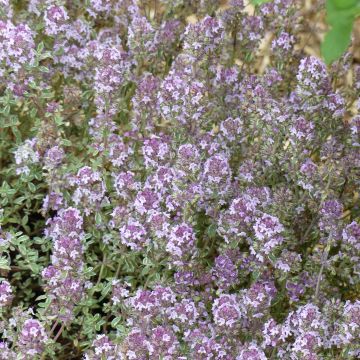
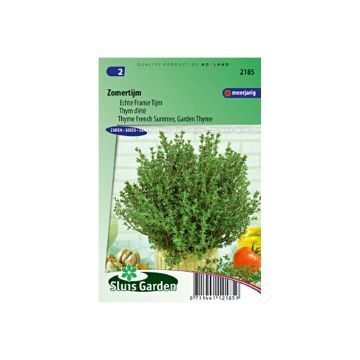
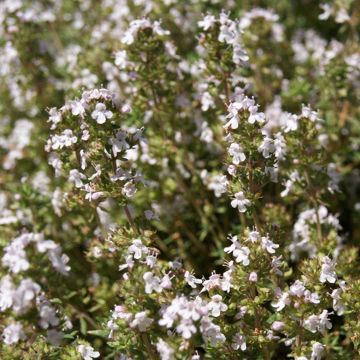
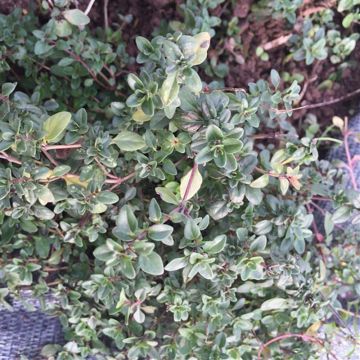
Comments